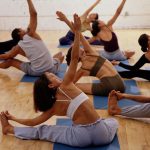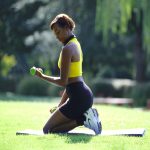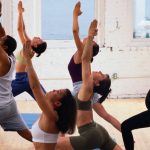(HealthDay News) — Fitness trackers can be great tools for improving heart health, says the Johns Hopkins University School of Medicine. Depending on what’s most comfortable for you, potential fitness trackers include pedometers, smartphone tracking apps or wearable devices. To use a fitness tracker properly, the school suggests: Use the tracker daily. Set healthy and realistic goals. Find activities that fit into your daily life. Recruit friends and family to use trackers, as well. Be accountable.
All Sports:
Sticking to One Sport Could Up Injuries Among Teen Athletes

Here’s a good reason to encourage your teenager to play more than one sport: New research finds kids who concentrate on only one sport may be at risk for stress fractures, tendinitis and knee injuries. “It’s wonderful for a child to love a sport and to want to engage in it, but we must keep in mind the number of hours spent playing,” said study author Alison Field, a professor of epidemiology and pediatrics at Brown University. “They add up pretty quickly.” The findings are a result of following more than 10,000 older children throughout the United States. The bottom line is that kids who do the most hours of intense activity per week, and that happens to be those focusing on a single sport, are the most likely to be injured. Field hopes that coaches, parents and doctors urge children to engage in less intense, less specialized training. The best advice is that kids should spend only a moderate amount of time in vigorous physical activity. If they have to specialize, they should replace some training with different types of exercise, such as yoga and conditioning, she suggested. The risk for injury differed for girls and boys. For girls, no sport stood out as being extra risky. Specializing, however, increased girls’ risk of injury by about 30%. Specialization did not significantly increase boys’ risk… read on >
Take a Fresh Look at Fitness Classes

Tired of taking the same old cardio class? It’s time to explore some of the combination classes being offered at both large gyms and small, more personalized fitness centers. One of the most popular options is the multi-discipline class — two or more activities woven into the same workout session, designed to keep fitness fun as well as challenge participants and avoid workout ruts. And there are many variations. A very rigorous combination takes the high-calorie burning technique of high-intensity interval training and applies it to strength training moves using only your body weight. By focusing on exercises like lunges and squats and not worrying about grabbing equipment, you can work through the moves quickly. Some creative combo classes mix various forms of dance, so you get a cardio workout as you learn different styles — that’s a great twist if you love Zumba, for instance, but want to shake it up even further. Adding an ab workout to a cardio class is another common offering. As different as they are, most of these mash-ups are designed to burn maximum calories, build lean muscle and increase stamina while keeping you engaged. Clever fitness teachers in your area might offer their own combinations, but some global pioneers have drawn from dynamic activities to make innovative combinations, like mixing Pilates with boxing and dance, and weight-training with… read on >
Health Tip: Muscle Strain Risk Factors
(HealthDay News) — Pulled muscles occur frequently in athletes. Most strains respond well to nonsurgical treatments, however, some strains can result in partial or complete tears, says the American Academy of Orthopaedic Surgeons. The academy mentions these risk factors for muscle strain: Muscle tightness. Athletes should always stretch. Muscle imbalance, which can occur during high-speed activities. Poor conditioning. Weak muscles are less able to cope with stress. Muscle fatigue, which makes muscles more susceptible to injury. Old age or adolescence. Athletes who participate in football, soccer, basketball, running, sprinting and dancing are especially at risk and should take extra precautions, the academy says.
Staying Healthy Now to Work Into Older Age

While you can take Social Security benefits at age 62 and get 75% of your maximum, waiting until you reach full retirement age (between age 66 and 67 depending on the year you were born) gets you much closer to the full amount. But the age at which Americans can collect the most dollars has inched up to 70. The problem is that, in general, people today aren’t as healthy during their pre-retirement years as past generations were. Having one or more chronic health conditions, from diabetes to arthritis, can make it harder to keep working through your 60s and, for those who want or need to, beyond. Though you might see retirement as being in the distant future, taking care of yourself today creates the foundation for a healthier and more productive old age. The American Academy of Family Physicians has seven key lifestyle habits to follow that can get you there. Build the Foundation for Lifelong Fitness Eat healthy: fruit, vegetables, legumes, nuts, whole grains and lean proteins. Get regular exercise — on nearly every day of the week. Lose weight if you’re overweight. Protect your skin every time you leave your home to help prevent skin cancer. Don’t smoke. Limit alcohol to a max of one drink a day for women, two for men. Less is better. Practice safe sex. Map out… read on >
How to Keep Your Feet on a Sound, Pain-Free Footing

Don’t let foot problems hobble your autumn activities, a foot surgeon says. “Foot health contributes to your overall health. From beginners to advanced athletes, proper foot care is important to keep your body healthy,” said Dr. John Giurini, chief of podiatric surgery at Beth Israel Deaconess Medical Center, in Boston. One of the most common foot problems among active people is plantar fasciitis, inflammation of the thick band of tissue in the arch of the foot. “Under normal circumstances, your plantar fascia helps absorb the shock of pounding on pavement,” Giurini said in a medical center news release. “But repetitive stretching can lead to inflammation and irritation, and even small tears.” Along with overuse, other risk factors for plantar fasciitis include being flat-footed or having a high arch, being overweight, or doing activities in worn-out or inappropriate footwear. “When caught early, mild cases can be treated conservatively with rest, ice and stretching to give the inflammation time to heal,” Giurini said. “In some cases, physical therapy and orthotic devices can be helpful. In more severe or resistant cases, steroid injections and surgical procedures may be necessary to alleviate this pain.” Blisters are another common foot problem and develop due to constant friction and moisture. Blisters can be painful and, if they break open, can become infected. “This is where proper shoe fit is important —… read on >
Experts’ Guide to Trampoline Safety

If you own or use trampolines, you need to take steps to prevent injuries, the American Academy of Orthopaedic Surgeons (AAOS) says. While trampolines are fun and can help improve coordination and strengthen the musculoskeletal system, serious injuries can occur without proper safety measures. In 2018, nearly 314,000 trampoline-related injuries were treated in U.S. emergency departments, doctors’ offices and clinics, according to the Consumer Product Safety Commission. A recent article in the Journal of the American Academy of Orthopaedic Surgeons noted that a higher percentage of fractures have been linked to trampoline and jump parks than home trampolines. “Many injuries come from multiple people jumping at once,” AAOS spokesman and pediatric orthopedic surgeon Dr. L. Reid Nichols said in an academy news release. “To limit injuries, ensure only one participant on a trampoline at a time. … Ensure rules are implemented and followed. Check also with your insurance rider before purchasing a home trampoline.” The AAOS offered the following trampoline safety tips: Don’t let children younger than 6 years old use trampolines and remove trampoline ladders after use to prevent unsupervised jumping. Regularly check equipment and discard worn or damaged equipment if replacement parts aren’t available. Make sure that supporting bars, strings and surrounding landing surfaces have adequate protective padding. See that the padding is in good condition and properly positioned. Don’t depend only on… read on >
Talking Health: The Vocabulary of Fitness

Doing the right amount of exercise every day is a top health goal. To make sure you’re getting all the right types of exercise, you want to get familiar with these key exercise terms. Then you can be sure these activities are all part of your weekly plan. Aerobic Exercise, AKA Cardio Aerobic exercise means activity that requires a continuous amount of oxygen to the muscles being used. For heart health, the exercise must raise your heart rate to within the ideal range for your age, usually 70% to 80% of 220 minus your age. Cardio activities include running, brisk walking, swimming and cycling. High-intensity interval training is a popular approach. Within a cardio workout, you alternate a few minutes of slow or no movement with shorter bursts of the activity at an all-out pace. Cross training is simply varying your choice of cardio activity within the same exercise session or on different days of the week. This lets you use different muscle groups, helps prevent overuse injuries and keeps things interesting. Anaerobic Exercise, AKA Strength Training You need strength training for healthy muscles, essential for everyday activities like just getting up from the sofa. Also called weight training or resistance training, these exercises work various sets of muscles. Strength training is anaerobic, because it doesn’t require extra oxygen. It should be done every second… read on >
Fitter Bodies Make for Healthier Brains, Study Finds

If you’re looking for incentives to hit the gym, new research suggests that staying in good shape may help preserve brain structure, boost memory, and improve the ability to think clearly and quickly. The finding follows an analysis of fitness and brain health among more than 1,200 young adults, average age 30. All underwent brain scans; tests to measure memory, sharpness, judgment and reasoning; and a speed-walking trial to assess cardiovascular fitness. (Muscle strength was not assessed.) The investigators found that study participants who moved faster and farther over the two-minute walking test performed better on thinking tests than their less-fit peers. Fitter men and women were also found to have healthier nerve fibers across the white matter portion of the brain. White matter is critical for high-quality neural communication, the researchers noted. Study lead author Dr. Jonathan Repple offered several theories as to what might explain a strong body/strong brain connection. For one, “exercise decreases inflammation, which then, in turn, is beneficial for brain cells,” said Repple, a psychiatrist and neuroscientist with the University of Muenster, in Germany. Being fit may also promote better nerve-fiber insulation, and greater growth across nerve cells and nerve connections, he explained. It may also be that fitter men and women simply have a “better blood supply to the brain,” Repple added. Dr. David Knopman, a professor of neurology… read on >
‘Hot’ Yoga, Hula Dance Your Way to Healthy Blood Pressure

Moderate exercise is known to improve blood pressure — and that may include activities that are more exotic than a brisk walk, two preliminary studies suggest. In one, researchers found that “hot” yoga classes lowered blood pressure in a small group of people with modestly elevated numbers. In the other, hula dancing showed the same benefit for people who had stubbornly high blood pressure, despite medication. Experts said the findings underscore the importance of exercise when it comes to blood pressure — and the value of finding an activity you enjoy. Hot yoga classes are held in a room that’s heated — usually to about 105 degrees Fahrenheit, though some centers keep the temperature less extreme. The practice is often touted as having health benefits, such as cleansing “toxins” from the body via sweat. For the study, Stacy Hunter and her team at Texas State University recruited 10 adults, ages 20 to 65. All participants had mildly elevated blood pressure: Their systolic pressure (the “top” number) ranged between 120 and 139 mm Hg, and their diastolic pressure was 89 mm Hg or lower. (Readings below 120/80 are considered normal.) The researchers randomly assigned five people to take hot yoga classes three times a week, for 12 weeks; the rest served as a comparison group. Over the 12 weeks, those who did yoga saw their systolic… read on >


















-300x200.jpg)










